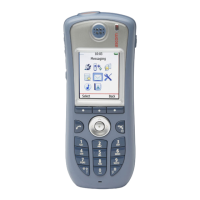TD 92477EN
8 April 2016 / Ver. M
User Manual
Ascom d62 DECT Handset
51
8.1.5 In Charger Action when not in Call
The behaviour of the handset placed in charger wh
en not in call can be set in one of the
following ways:
1 Select “In charger”.
2 Select "Other actions".
3 Select one of the following:
• No action - no action is performed when handset is not in call and place
d in
charger.
• Change profile - when the handset is placed in the charger
it changes profile.
When the handset is removed from the charger, the profile is changed back.
Press "Edit" and select the wanted profile. By default only the profile No
rmal is
selectable, but additional profiles are visible if they are configured. See 8.6
Profiles on
page 63.
• Switch off - When the handset is placed in t
he charger it switches off. When it is
removed from the charger it switches on again. NOTE: If handset restrictions are
enabled, the handset might not be switched off when placed in charger.
• Sound off - When the handset is placed in the charger
it is muted. When it is
removed from the charger it switches the sound on again. When the handset is
switched off in the charger, the Owner ID of the handset is still displayed. This
simplifies the identification of the handset when, for example, it is being charged
with other handsets. NOTE: If handset restrictions are enabled, the handset might
not be silenced when placed in charger.
• Logout - When the handset is placed in a charger it
is logged off. Call list and
message list are deleted when the handset is logged out. When it is removed from
the charger, the user needs to log on again. NOTE: This feature is license
dependent and applicable in IP-DECT systems only. See also 4.2 Log a Shared
Phone On and Off on
page 22.
• Message absence - When an application or system sends a message to a handset,
it
receives an indication that the handset is absent. If a handset is absent, the
application or system determines if the message is to be sent to the handset or
not, or redirected to another handset.
NOTE: If a message is sent from a handset, it does not receive an indication t
hat
the recipient is absent. This function must be programmed in the PBX to be able
to redirect calls and messages.
NOTE: Additional "In charger" actions to those listed above can also be configured. For
add
itional information, see the Configuration Manual, Ascom d62 DECT Handset, TD
92639EN.
8.2 Calls
1 Enter the menu by pressing the “Menu” Soft key, or the confirmation button on the
Navigation key.
2 Select
in the menu, and press the confirmation button or the Soft key "Select".

